Google Vertex AI
by Stephen M. Walker II, Co-Founder / CEO
What is GCP Vertex?
GCP Vertex, officially known as Google Cloud Vertex AI, is a managed machine learning (ML) platform that developers, data scientists, and researchers use to build, deploy, and manage high-quality, scalable ML models. These models are then capable of making predictions from data.
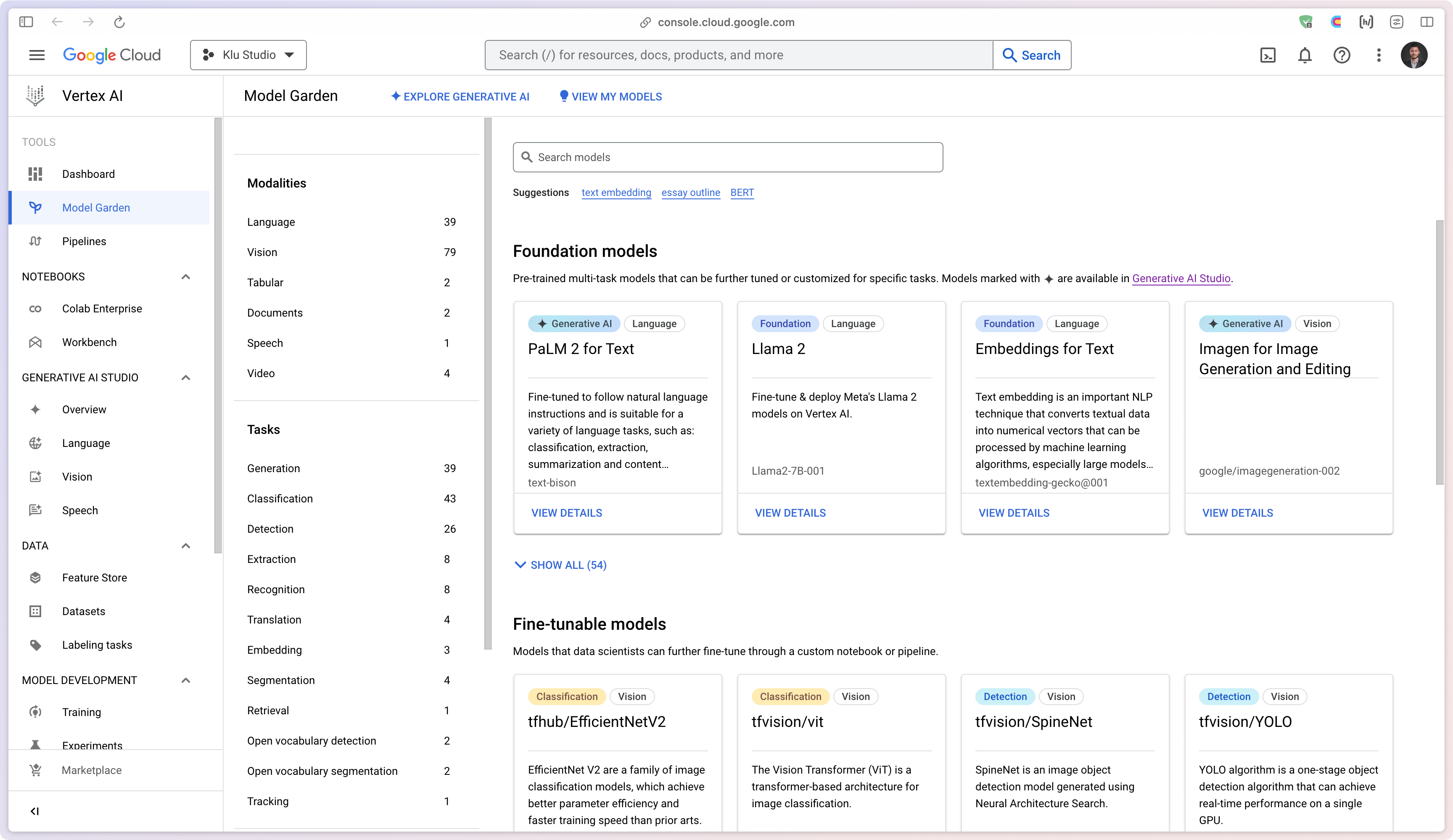
The features of GCP Vertex AI cover the full spectrum of ML workflows including training, evaluation, interference/prediction, and model versioning among others. It enables enterprise developers to utilize Google's pre-trained models or create their own custom models, thereby enabling them to transform their ideas into practical applications seamlessly.
What can I build with GCP Vertex?
Google Cloud's Vertex AI is a unified platform for machine learning (ML) and artificial intelligence (AI) applications. It allows you to train, deploy, and customize ML models and AI applications, including large language models (LLMs).
Vertex AI combines data engineering, data science, and ML engineering workflows, enabling teams to collaborate using a common toolset and scale applications using the benefits of Google Cloud.
Top tip
Klu LLM Platform integrates with Google Gemini and PaLM 2 models (Text & Chat Bison), which offer superior performance in certain use cases that demand quick responses and translation capabilities.

Vertex AI provides several options for model training and deployment. AutoML allows you to train models on tabular, image, text, or video data without writing code or preparing data splits. Custom training gives you complete control over the training process, including using your preferred ML framework, writing your own training code, and choosing hyperparameter tuning options.
Vertex Features
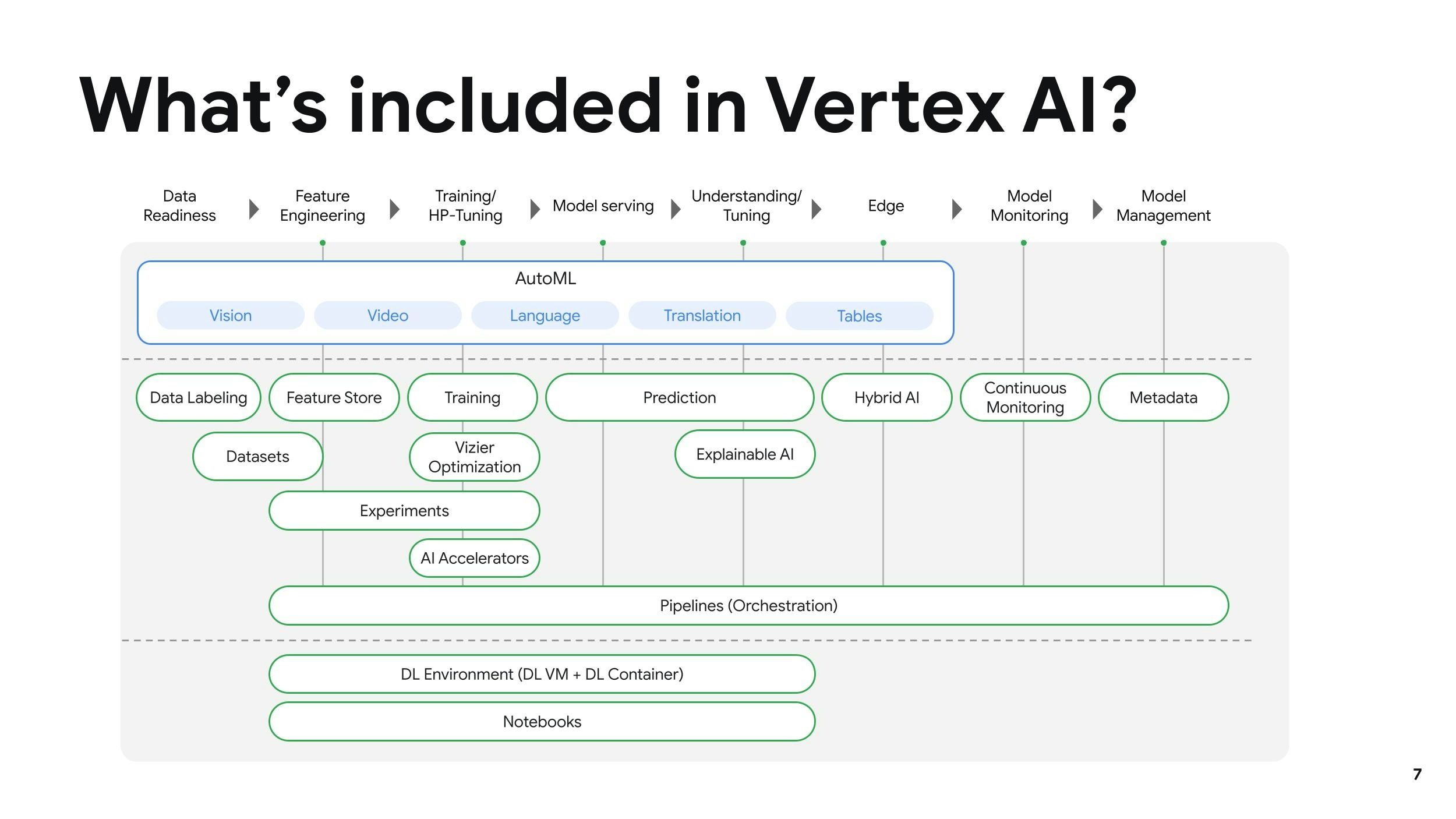
Model Garden lets you discover, test, customize, and deploy Vertex AI and select open-source models and assets. Generative AI gives you access to Google's large generative AI models for multiple modalities.
Tools
- Dashboard: Provides a comprehensive overview of your ML projects.
- Model Garden: Discover, test, customize, and deploy Vertex AI and select open-source models.
- Pipelines: Orchestrate complex ML workflows in a scalable, repeatable, and reliable manner.
Notebooks
- Colab Enterprise: A collaborative environment for data science and ML development.
- Workbench: An integrated development environment for building, training, and deploying models.
Vertex AI Studio
- Overview: A centralized hub for managing ML projects.
- Multimodal, Language, Vision, Speech: Specialized tools for different AI modalities.
- Prompt Gallery and Saved Prompts: Manage and reuse prompts for AI models.
- Tuning: Optimize model performance through hyperparameter tuning.
Build with Gen AI
- Extensions: Enhance your models with generative AI capabilities.
Data
- Feature Store: Manage and serve feature data from a BigQuery data source.
- Datasets and Labeling Tasks: Organize and prepare data for ML projects.
Model Development
- Training and Experiments: Conduct experiments and train models with full control.
- Metadata: Track and manage model metadata for better organization.
Deploy and Use
- Model Registry: Manage model versions and deployments.
- Online and Batch Predictions: Perform real-time and batch predictions.
- Monitoring and Vector Search: Ensure model performance and explore data efficiently.
Manage
- Ray on Vertex AI: Utilize Ray for distributed computing and scaling ML workloads.

Vertex AI also includes a feature store, which offers a new approach to feature management by letting you maintain and serve your feature data from a BigQuery data source. This feature store acts as a metadata layer that provides online serving capabilities to your feature data source in BigQuery and lets you serve features online based on that data.
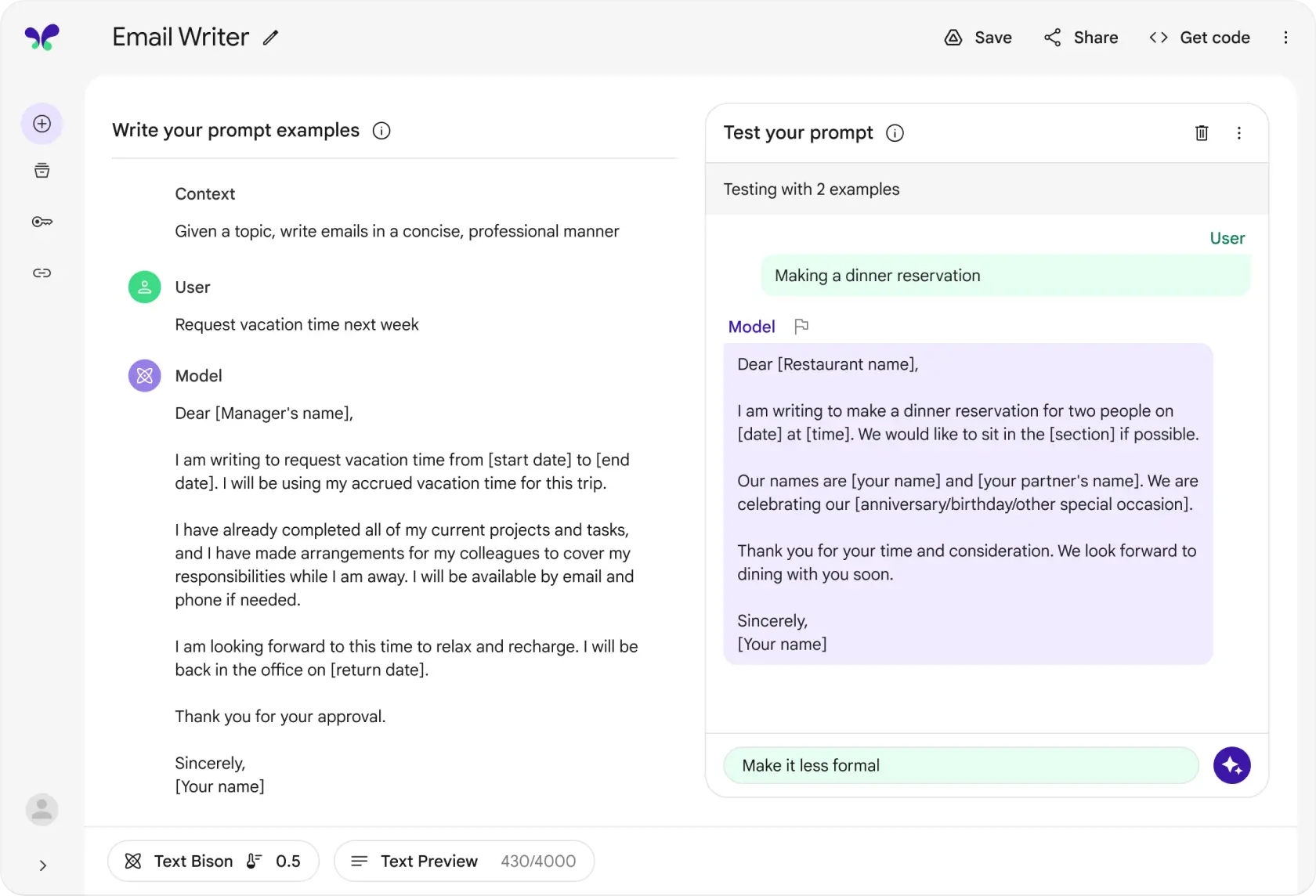
The platform is designed to support the entire machine-learning workflow, including data preparation, model training, model evaluation, model deployment, model monitoring, and model explainability. It also supports open-source frameworks like PyTorch and TensorFlow, making it an ideal target platform for any organization wanting to move their models to the cloud.
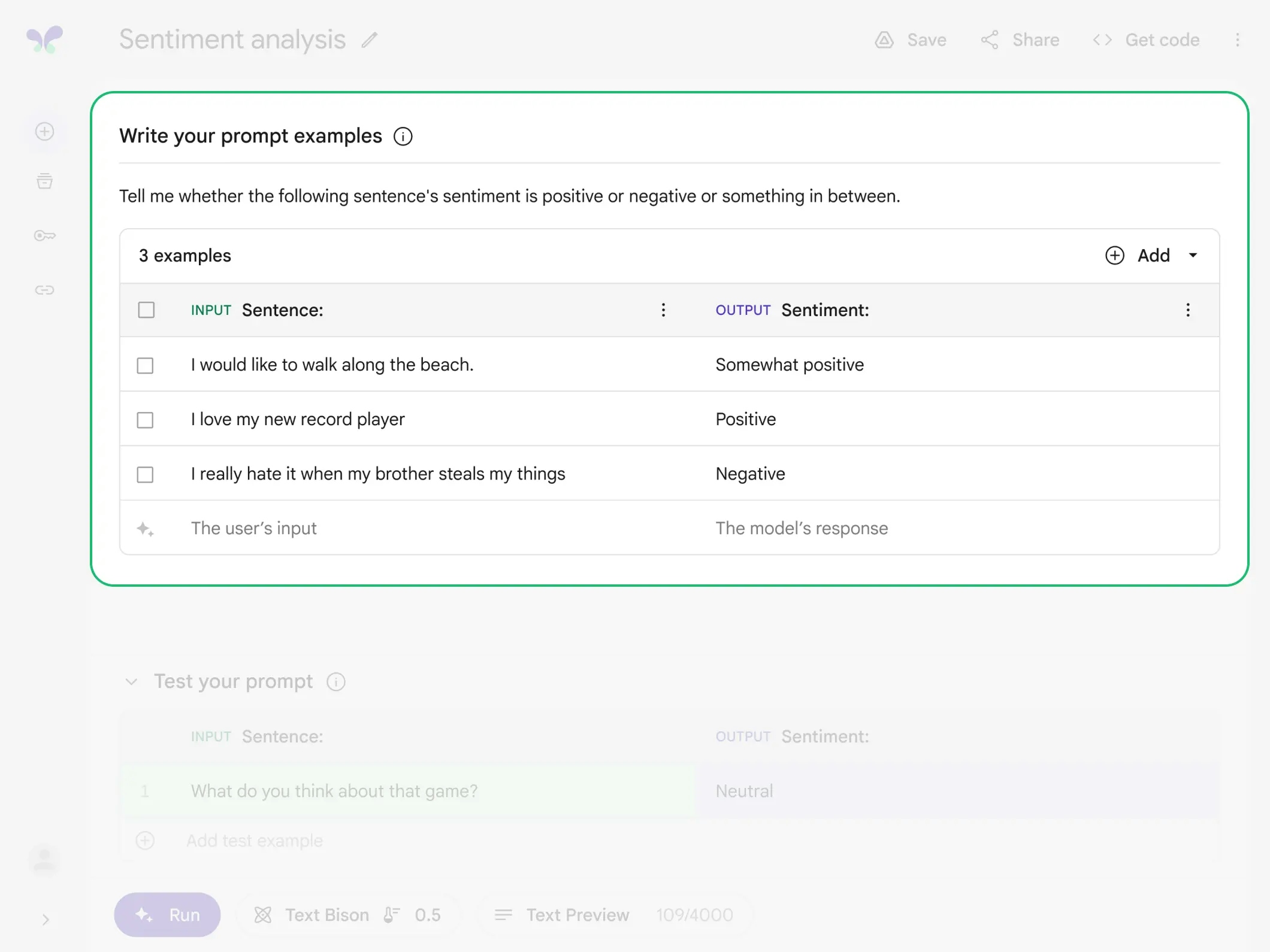
High-profile Vertex AI customers include Ford, Seagate, Wayfair, Cashapp, Cruise, and Lowe's. The pay-as-you-use resource billing model makes Vertex AI a potential choice for smaller organizations as well. However, it's important to note that Vertex AI is not free. As a cloud-based platform, Vertex AI is billed according to the compute resources and services used.
How does GCP Vertex work?
GCP Vertex is a managed machine learning platform provided by Google Cloud. It is designed to make it easier for developers to build, deploy, and scale AI models. It provides a unified UI for all AI and machine learning operations, making it ideal for applications that require fast development and deployment of complex machine learning models.
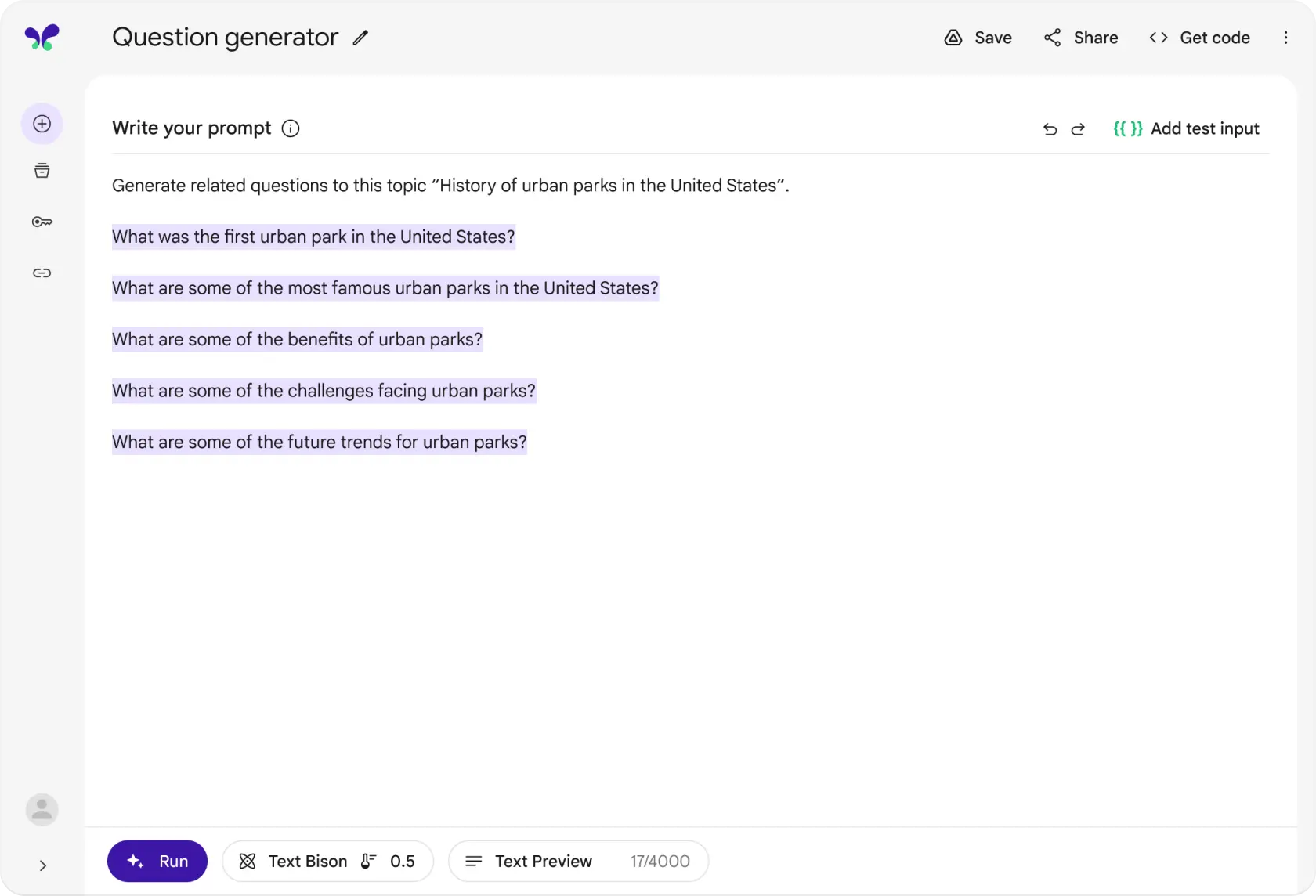
In GCP Vertex, models are trained using Google's advanced machine learning algorithms and can be deployed in the cloud or on-premises. This allows developers to focus on building their applications, without having to worry about the underlying infrastructure.
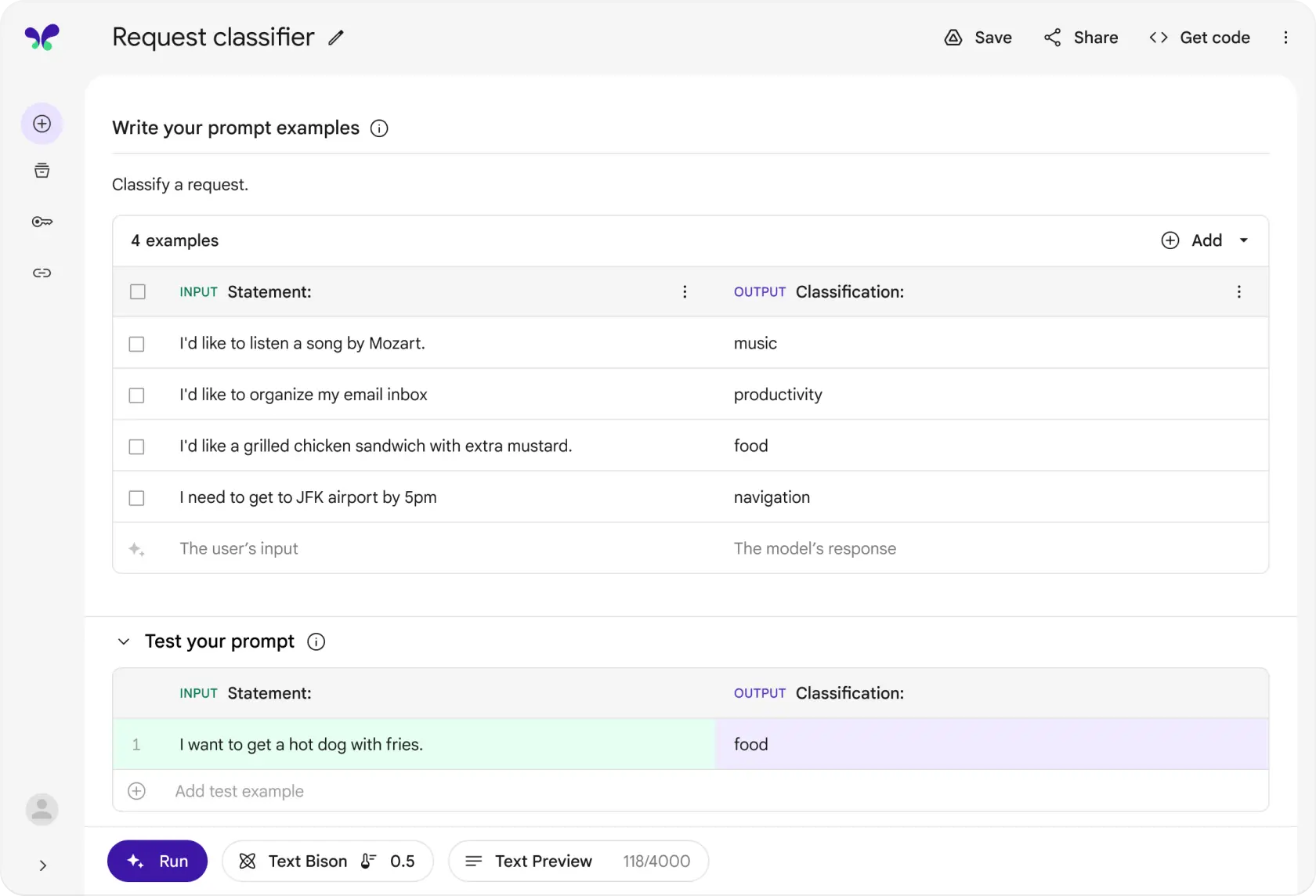
GCP Vertex is designed to handle large volumes of data and can scale horizontally to accommodate growing data needs. It also supports distributed computing, allowing it to process large amounts of data in parallel, which can significantly improve performance.
What are some common use cases for GCP Vertex?
GCP Vertex is used in a wide range of applications, particularly those that involve complex data and require fast development and deployment of machine learning models. Some common use cases include:
-
Machine Learning and Artificial Intelligence — GCP Vertex is ideal for building and deploying the high-dimensional models used in machine learning and AI. It can handle the large volumes of data required for training models, and its advanced machine learning algorithms make it well-suited for tasks such as predictive analytics and natural language processing.
-
Big Data Analytics — GCP Vertex can handle the large volumes of data involved in big data analytics. It can process large amounts of data in parallel, making it ideal for tasks such as real-time analytics and data mining.
-
Recommendation Systems — GCP Vertex can be used to build recommendation systems, such as those used in e-commerce websites or streaming platforms. Its ability to process large volumes of data and its advanced machine learning algorithms make it well-suited for tasks such as predicting user preferences and recommending products or content.
-
Image and Video Recognition — GCP Vertex can be used to build image and video recognition models, such as those used in security systems or social media platforms. Its advanced machine learning algorithms make it well-suited for tasks such as image classification and object detection.
-
Natural Language Processing (NLP) — GCP Vertex can be used to build NLP models, such as those used in chatbots or voice assistants. Its advanced machine learning algorithms make it well-suited for tasks such as sentiment analysis and language translation.
What are some common GCP Vertex tools?
There are several tools available for working with GCP Vertex. Some of the most popular include:
-
Vertex AI Workbench — This is an integrated development environment (IDE) for machine learning that provides a collaborative space for data scientists and developers to build, train, and deploy models.
-
Vertex Pipelines — This tool allows developers to orchestrate machine learning workflows, which can be complex and involve multiple steps, in a scalable, repeatable, and reliable way.
-
Vertex TensorBoard — This is a suite of visualization tools for machine learning experiments. It allows developers to track and visualize metrics such as loss and accuracy, visualize model graphs, view histograms of weights, biases, or other tensors as they change over time, and much more.
These tools provide a range of features for working with GCP Vertex, from model building and training to deployment and monitoring.
What are the leading managed machine learning platforms for AI projects?
Apart from GCP Vertex, there are other managed machine learning platforms that provide efficient and scalable solutions for building, deploying, and managing AI models. These include Amazon SageMaker, Azure Machine Learning, and IBM Watson Studio.
Amazon SageMaker is a fully managed service that provides developers and data scientists with the ability to build, train, and deploy machine learning models quickly. SageMaker includes modules that can be used together or independently to build, train, and deploy your machine learning models.
Azure Machine Learning is a cloud-based environment you can use to train, deploy, automate, manage, and track ML models. It supports a wide range of machine learning and deep learning frameworks.
IBM Watson Studio is a platform for businesses to prepare and analyze data, build machine learning models, and deploy and manage AI-powered applications. It provides tools for data scientists, application developers, and subject matter experts to collaboratively and easily work with data and use that data to build, train, and deploy models.
All these platforms are designed to handle large-scale datasets, support real-time analytics and queries, and offer improved performance and reduced latency in machine learning and AI applications. They also provide efficient storage and indexing of high-dimensional data and can handle vectors derived from complex data types such as images, videos, and natural language text.
Frequently Asked Questions (FAQs) about GCP Vertex AI
What is Vertex AI and how can it be integrated into my projects?
Vertex AI is a managed machine learning platform that allows you to build, deploy, and scale ML models with ease. It can be integrated into your projects by using Google Cloud services and tools, which provide a seamless way to enhance your applications with AI capabilities.
How does Google Cloud support machine learning and AI?
Google Cloud provides a suite of tools and services that support machine learning and AI, including Vertex AI, which offers advanced ML algorithms and the ability to process large volumes of data for training and deploying models.
Can I use Google Cloud Vertex AI for custom model training?
Yes, Google Cloud Vertex AI supports custom model training, allowing you to tailor your ML models to specific datasets and use cases, ensuring that your models are as effective and efficient as possible.
What are the benefits of using generative AI in Google Cloud?
Generative AI in Google Cloud can help create new content, predict outcomes, and automate tasks. It's particularly useful for applications that require a high degree of creativity or predictive analysis, such as content generation or trend forecasting.
How can AI platforms like Vertex AI handle global scale projects?
AI platforms like Vertex AI are designed to handle projects on a global scale by providing robust infrastructure that can scale horizontally to meet increasing data demands and computational needs.
What are the key features of Google Cloud's AI and machine learning services?
Key features of Google Cloud's AI and machine learning services include the ability to process and analyze large datasets, advanced ML algorithms for a variety of applications, and tools for every stage of the ML lifecycle, from data preparation to model deployment.
How can data scientists benefit from Google Cloud's machine learning models?
Data scientists can benefit from Google Cloud's machine learning models by leveraging pre-trained models or customizing their own, accessing powerful computing resources, and utilizing tools for data analysis, model training, and deployment.
What is the importance of hyperparameter tuning in machine learning?
Hyperparameter tuning is crucial in machine learning as it involves optimizing the parameters that govern the training process of a model. This can lead to improved model performance and more accurate predictions.
How can I ensure the security of my machine learning projects on Google Cloud?
You can ensure the security of your machine learning projects on Google Cloud by utilizing Google's robust security features, including encryption, access controls, and compliance with data protection regulations.
What tools are available for deploying machine learning models in Google Cloud?
Google Cloud offers various tools for deploying machine learning models, such as Vertex AI, which provides a managed environment for deploying and monitoring your models, ensuring they perform optimally.
How can I use Google Cloud's AI services for image and video recognition tasks?
Google Cloud's AI services offer specialized tools for image and video recognition tasks, such as pre-trained models and APIs that can be easily integrated into your applications for tasks like object detection and classification.
What are the advantages of using APIs for machine learning in Google Cloud?
Using APIs for machine learning in Google Cloud provides advantages such as ease of integration, scalability, and access to advanced ML capabilities without the need for extensive machine learning expertise.
How can developers leverage Google Cloud's machine learning solutions for their applications?
Developers can leverage Google Cloud's machine learning solutions by integrating APIs and services into their applications to add AI features such as language translation, content recommendation, and predictive analytics.
What is the role of data management in machine learning with Google Cloud?
Data management plays a critical role in machine learning with Google Cloud as it ensures that data is organized, accessible, and of high quality, which is essential for training accurate and reliable models.
How can I get started with machine learning on Google Cloud?
To get started with machine learning on Google Cloud, you can explore the various tools and services offered, such as Vertex AI, and take advantage of Google's documentation and resources to learn how to build and deploy your first model.
What are some common use cases for machine learning in Google Cloud?
Common use cases for machine learning in Google Cloud include predictive analytics, natural language processing, recommendation systems, and image and video analysis, among others.
How does Google Cloud facilitate collaboration among ML engineers and data scientists?
Google Cloud facilitates collaboration among ML engineers and data scientists by providing shared workspaces, collaborative tools like Vertex AI Workbench, and the ability to easily share models and datasets across teams.
Can I perform online predictions with Google Cloud's machine learning services?
Yes, you can perform online predictions with Google Cloud's machine learning services, which allow you to make real-time predictions using deployed models, providing immediate insights and responses.
What support is available for deploying machine learning models at scale in Google Cloud?
Google Cloud offers extensive support for deploying machine learning models at scale, including managed services, scalable infrastructure, and guidance on best practices for high-performance and efficient deployments.
How can I use Google Cloud's machine learning services for real-time analytics?
You can use Google Cloud's machine learning services for real-time analytics by leveraging tools like BigQuery ML and real-time prediction capabilities of Vertex AI to analyze streaming data and make instant decisions.
What are the options for training machine learning models in Google Cloud?
Options for training machine learning models in Google Cloud include using Vertex AI for automated and custom training, as well as utilizing various machine learning frameworks and pre-trained models to accelerate development.
How can I ensure my machine learning models are cost-effective in Google Cloud?
To ensure your machine learning models are cost-effective in Google Cloud, you can take advantage of Google's pricing models, use pre-emptible resources, and optimize your models for efficiency to reduce computational costs.
What is the process for building and deploying custom machine learning models in Google Cloud?
The process for building and deploying custom machine learning models in Google Cloud involves preparing your data, selecting the appropriate model architecture, training your model, and deploying it using services like Vertex AI.
How can I access machine learning capabilities in Google Cloud without extensive coding?
You can access machine learning capabilities in Google Cloud without extensive coding by using pre-built models and APIs, which allow you to integrate AI features into your applications with minimal development effort.
What are the best practices for machine learning model development in Google Cloud?
Best practices for machine learning model development in Google Cloud include following the ML lifecycle, utilizing Google's tools and services for each stage, and adhering to principles of responsible AI and data governance.
How can I use Google Cloud's machine learning services to analyze text data?
You can use Google Cloud's machine learning services to analyze text data by employing natural language processing tools and APIs that provide capabilities such as sentiment analysis, entity recognition, and content classification.
What are the first steps to take when starting a machine learning project in Google Cloud?
The first steps to take when starting a machine learning project in Google Cloud include defining your objectives, gathering and preparing your data, exploring available tools and services, and setting up your development environment.
How can I use Google Cloud's AI and machine learning services to enhance customer experiences?
You can use Google Cloud's AI and machine learning services to enhance customer experiences by personalizing content, providing intelligent recommendations, and automating customer interactions with chatbots and virtual assistants.
What are the considerations for choosing the right machine learning service in Google Cloud for my project?
Considerations for choosing the right machine learning service in Google Cloud for your project include the scale of your data, the complexity of the task, the level of customization required, and the resources available for model training and deployment.
How can I learn more about machine learning and AI in Google Cloud?
To learn more about machine learning and AI in Google Cloud, you can explore Google's documentation, take online courses, participate in Q&A forums, and experiment with Google Cloud services to gain hands-on experience.
What are the advantages of using Google Cloud for AI and ML projects compared to other platforms?
The advantages of using Google Cloud for AI and ML projects compared to other platforms include access to Google's cutting-edge AI research, a wide range of machine learning tools and services, and a global infrastructure that ensures scalability and reliability.
How can I optimize my machine learning models for better performance in Google Cloud?
To optimize your machine learning models for better performance in Google Cloud, you can utilize hyperparameter tuning, experiment with different model architectures, and leverage Google's advanced optimization tools and services.
Can I use Google Cloud's machine learning services for educational purposes or beginner projects?
Yes, Google Cloud's machine learning services are suitable for educational purposes and beginner projects, offering user-friendly interfaces, comprehensive tutorials, and resources that cater to learners at all levels.
What are the steps involved in deploying a machine learning model in Google Cloud?
The steps involved in deploying a machine learning model in Google Cloud include training your model, evaluating its performance, configuring the deployment settings, and using services like Vertex AI for seamless model serving.
How can I track the performance of my machine learning models in Google Cloud?
You can track the performance of your machine learning models in Google Cloud by using monitoring tools like Vertex AI's model monitoring feature, which provides insights into model accuracy, prediction quality, and resource usage.
What are the challenges of machine learning model deployment and how does Google Cloud address them?
Challenges of machine learning model deployment include scalability, performance, and security. Google Cloud addresses these challenges by offering managed services, scalable infrastructure, and robust security measures to ensure successful deployments.
How can I use Google Cloud's machine learning services to process and analyze large datasets?
You can use Google Cloud's machine learning services to process and analyze large datasets by leveraging scalable data storage solutions, powerful data processing tools, and machine learning algorithms optimized for big data.
What are the benefits of using pre-trained machine learning models in Google Cloud?
The benefits of using pre-trained machine learning models in Google Cloud include saving time and resources on model development, accessing models trained on vast datasets, and achieving high-quality results with minimal effort.
How does Google Cloud ensure the privacy and security of data used in machine learning projects?
Google Cloud ensures the privacy and security of data used in machine learning projects by implementing strict data protection policies, encryption, access controls, and compliance with global data privacy regulations.
Can I customize the machine learning services in Google Cloud to fit my specific needs?
Yes, you can customize the machine learning services in Google Cloud to fit your specific needs by using custom model training, fine-tuning pre-trained models, and integrating with other Google Cloud services for a tailored solution.
What kind of support does Google Cloud offer for machine learning and AI research?
Google Cloud offers support for machine learning and AI research by providing access to advanced AI tools, collaboration with Google researchers, and funding opportunities for innovative projects in the field of AI.
How can I leverage Google Cloud's machine learning services for predictive analytics?
You can leverage Google Cloud's machine learning services for predictive analytics by using tools like BigQuery ML and Vertex AI to build and deploy models that can forecast trends, behaviors, and outcomes based on historical data.
What are the options for visualizing machine learning model performance in Google Cloud?
Options for visualizing machine learning model performance in Google Cloud include using TensorBoard for detailed visualizations of model training, as well as integrating with data visualization tools like Data Studio for comprehensive reporting.
How can I ensure that my machine learning models are fair and unbiased when using Google Cloud services?
To ensure that your machine learning models are fair and unbiased when using Google Cloud services, you should use diverse and representative datasets, regularly evaluate model fairness, and follow Google's AI principles and best practices.
What are the considerations for scaling machine learning models in Google Cloud?
Considerations for scaling machine learning models in Google Cloud include the computational resources required, the size of the datasets, the complexity of the models, and the need for distributed training and deployment strategies.
How can I use Google Cloud's machine learning services for natural language processing tasks?
You can use Google Cloud's machine learning services for natural language processing tasks by utilizing pre-trained models and APIs for language understanding, translation, and text analysis, as well as custom training for specialized NLP applications.
What are the benefits of using Google Cloud's AI and machine learning services for startups and small businesses?
The benefits of using Google Cloud's AI and machine learning services for startups and small businesses include cost-effectiveness, scalability, access to advanced AI capabilities, and the ability to innovate quickly with minimal infrastructure investment.
How can I integrate Google Cloud's machine learning services with other cloud platforms or on-premises systems?
You can integrate Google Cloud's machine learning services with other cloud platforms or on-premises systems by using APIs, connectors, and hybrid cloud solutions that allow for seamless data exchange and model deployment across different environments.
What are the best practices for managing the machine learning lifecycle in Google Cloud?
Best practices for managing the machine learning lifecycle in Google Cloud include following a structured process for model development, utilizing version control for datasets and models, automating model training and deployment, and continuously monitoring and updating models.
How can I use Google Cloud's machine learning services to improve the accuracy of my models?
You can use Google Cloud's machine learning services to improve the accuracy of your models by leveraging hyperparameter tuning, experimenting with different model architectures, and using high-quality, well-prepared datasets for training.
What are the options for automating machine learning workflows in Google Cloud?
Options for automating machine learning workflows in Google Cloud include using Vertex AI Pipelines to orchestrate complex ML workflows, employing AutoML for automated model selection and training, and integrating with Cloud Functions for event-driven automation.
How can I use Google Cloud's machine learning services for image and video analysis?
You can use Google Cloud's machine learning services for image and video analysis by utilizing pre-trained models for tasks like object detection and image classification, as well as custom training for specialized use cases in various industries.
What are the advantages of using Google Cloud's machine learning services for real-time decision making?
The advantages of using Google Cloud's machine learning services for real-time decision making include the ability to process and analyze data in real-time, deploy models that respond instantly to new information, and integrate with streaming data services for continuous insights.
How can I ensure the reliability and uptime of my machine learning models deployed in Google Cloud?
To ensure the reliability and uptime of your machine learning models deployed in Google Cloud, you should utilize Google's managed services, implement redundancy and failover strategies, and monitor your models' performance and health continuously.
What are the options for training and deploying large-scale machine learning models in Google Cloud?
Options for training and deploying large-scale machine learning models in Google Cloud include using high-performance computing resources, distributed training techniques, and managed services like Vertex AI for scalable model deployment.
How can I use Google Cloud's machine learning services to gain insights from complex datasets?
You can use Google Cloud's machine learning services to gain insights from complex datasets by employing advanced analytics tools, machine learning algorithms, and data processing services that can handle high-dimensional data and complex data types.
What are the benefits of using Google Cloud's pre-trained machine learning models for quick deployment?
The benefits of using Google Cloud's pre-trained machine learning models for quick deployment include reduced development time, access to models trained on extensive datasets, and the ability to achieve high-quality results with minimal customization.
How does Google Cloud support the development of custom machine learning models for unique use cases?
Google Cloud supports the development of custom machine learning models for unique use cases by providing flexible tools for model training, a wide range of machine learning frameworks, and the ability to integrate with custom datasets and specialized algorithms.
What are the considerations for choosing the right machine learning framework in Google Cloud?
Considerations for choosing the right machine learning framework in Google Cloud include the specific requirements of your project, the level of expertise required, the compatibility with other tools and services, and the support for the desired machine learning techniques.
How can I use Google Cloud's machine learning services to enhance the capabilities of my mobile and web applications?
You can use Google Cloud's machine learning services to enhance the capabilities of your mobile and web applications by integrating APIs for features like image recognition, language translation, and personalized recommendations, providing a more engaging user experience.
What are the options for managing data privacy and compliance when using machine learning in Google Cloud?
Options for managing data privacy and compliance when using machine learning in Google Cloud include utilizing data encryption, implementing access controls, adhering to data residency requirements, and following industry-specific regulations.
How can I use Google Cloud's machine learning services for time-series analysis and forecasting?
You can use Google Cloud's machine learning services for time-series analysis and forecasting by employing tools like BigQuery ML and Vertex AI to build models that can predict future trends and patterns based on historical data sequences.
What are the benefits of using Google Cloud's AI and machine learning services for research and academic purposes?
The benefits of using Google Cloud's AI and machine learning services for research and academic purposes include access to cutting-edge technology, collaboration opportunities with Google researchers, and educational resources to support learning and innovation in the field of AI.
How can I use Google Cloud's machine learning services to automate repetitive tasks and processes?
You can use Google Cloud's machine learning services to automate repetitive tasks and processes by leveraging AI-powered tools that can handle tasks like data entry, content moderation, and customer support, freeing up time for more strategic work.
What are the options for integrating Google Cloud's machine learning services with IoT devices and systems?
Options for integrating Google Cloud's machine learning services with IoT devices and systems include using Cloud IoT Core for device management, employing Edge TPU for on-device machine learning, and leveraging AI Platform for model training and deployment.
How can I use Google Cloud's machine learning services to improve the performance of my e-commerce platform?
You can use Google Cloud's machine learning services to improve the performance of your e-commerce platform by implementing personalized recommendation systems, optimizing search functionality, and analyzing customer behavior to enhance the shopping experience.
What are the considerations for ensuring ethical use of AI and machine learning in Google Cloud?
Considerations for ensuring ethical use of AI and machine learning in Google Cloud include using unbiased datasets, regularly evaluating model fairness, adhering to Google's AI principles, and being transparent about the use of AI in decision-making processes.
How can I use Google Cloud's machine learning services for sentiment analysis and customer feedback?
You can use Google Cloud's machine learning services for sentiment analysis and customer feedback by employing natural language processing tools that can analyze text data, identify sentiment, and extract valuable insights from customer interactions.
What are the options for scaling up machine learning operations (MLOps) in Google Cloud?
Options for scaling up machine learning operations (MLOps) in Google Cloud include using Vertex AI for end-to-end MLOps, automating model training and deployment pipelines, and leveraging Google's infrastructure for high-performance computing and storage.